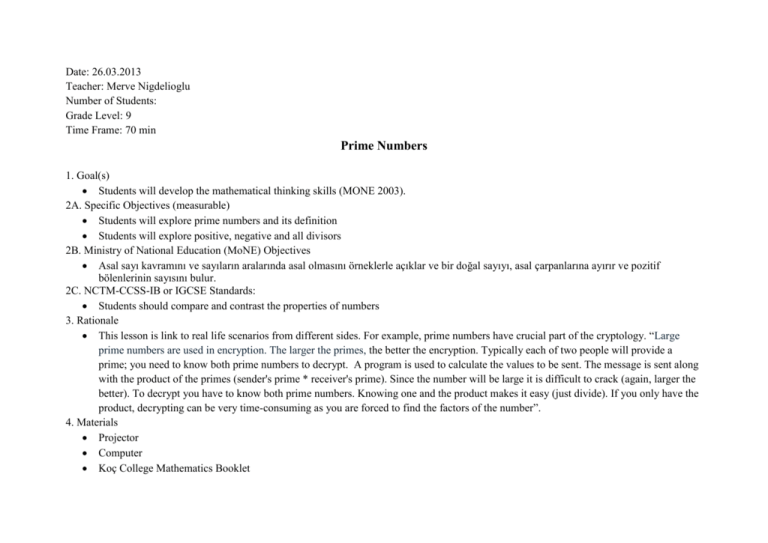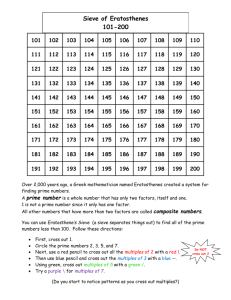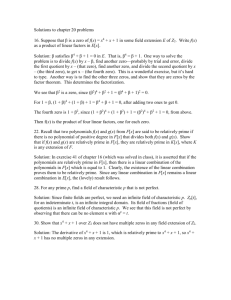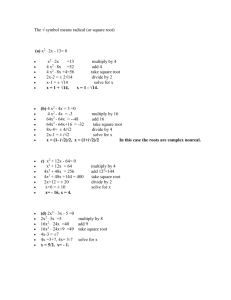File
advertisement

Date: 26.03.2013 Teacher: Merve Nigdelioglu Number of Students: Grade Level: 9 Time Frame: 70 min Prime Numbers 1. Goal(s) Students will develop the mathematical thinking skills (MONE 2003). 2A. Specific Objectives (measurable) Students will explore prime numbers and its definition Students will explore positive, negative and all divisors 2B. Ministry of National Education (MoNE) Objectives Asal sayı kavramını ve sayıların aralarında asal olmasını örneklerle açıklar ve bir doğal sayıyı, asal çarpanlarına ayırır ve pozitif bölenlerinin sayısını bulur. 2C. NCTM-CCSS-IB or IGCSE Standards: Students should compare and contrast the properties of numbers 3. Rationale This lesson is link to real life scenarios from different sides. For example, prime numbers have crucial part of the cryptology. “Large prime numbers are used in encryption. The larger the primes, the better the encryption. Typically each of two people will provide a prime; you need to know both prime numbers to decrypt. A program is used to calculate the values to be sent. The message is sent along with the product of the primes (sender's prime * receiver's prime). Since the number will be large it is difficult to crack (again, larger the better). To decrypt you have to know both prime numbers. Knowing one and the product makes it easy (just divide). If you only have the product, decrypting can be very time-consuming as you are forced to find the factors of the number”. 4. Materials Projector Computer Koç College Mathematics Booklet 5. Resources Koç College Mathematics Booklet http://www.softschools.com/math/prime_numbers/prime_numbers_up_to_100/ http://www.sheppardsoftware.com/mathgames/numbers/fruit_shoot_prime.htm 6. Getting Ready for the Lesson (Preparation Information) Teacher does not have to do any special seated plan for this lesson but students should see your face and the board all the time Teacher can use other activities in order to assess students’ understanding Teacher should be careful about prime number’s properties Teacher should investigate why “0 and 1” or “negative numbers” are not prime numbers Teacher should have five or six copies of the Koç booklet (p.97-99) to take a precaution 7. Prior Background Knowledge (Prerequisite Skills) Students should know how to find the set of positive divisors of numbers Students should know how to find common divisors of numbers Lesson Procedures Transition: Hi, I am Merve. We will do this lesson together. I want you to write your names on these small papers that I can easily learn your names. I hope you will learn prime numbers and enjoy while learning. Let’s start. What do you know about prime numbers? 8A. Engage (10 min) Start with talking about mersenne prime (In mathematics, a Mersenne prime is a prime number of the form ) (As of February 2013, 48 Mersenne primes are known. The largest known prime number − 1) is a Mersenne prime. Since 1997, all newly-found Mersenne primes have been discovered by the “Great Internet Mersenne Prime Search” (GIMPS), adistributed computing project on the Internet.) (257,885,161 Why we need to learn prime number? Do we have to learn? Prime numbers are used in cryptology. Cryptology is the study of using secret writing. This is used to keep some government information secret. It is also used on the Internet to help keep certain information private. For example, if your parents buy something on the Internet with a credit card, a prime number is used to send their number to the online store. This keeps another person from finding your parent's credit card number and using it to buy things. Prime numbers have no simple equation to represent them, so they can only be computed by brute force. This is great news for people who want to hide information in a number. So primes are useful for encryption. Think about counting numbers. You can never find the biggest number. Every time you have a big number, you can always count to a higher number. Prime numbers are like this. Many years ago, Euclid proved that there are an unlimited number of primes. No one can find the biggest prime number. There is always a bigger prime number than the biggest one known. There was news about prime numbers in CNN. Last year someone found the biggest prime number which is twice as much the previous one. Discuss about meaning of prime numbers Ask students to define prime numbers Open the projector and then open the number table from 1 to 100 Ask students to mark multiples of 2, 3, 5, 7, 11 and so on until the 100. (I want you to mark multiples of 2) Ask students the number left on the table and what it is mean? Transition: let’s think about 1 and 0. B. Explore (5 min) Ask students “Why 1 and 0 are not prime numbers?” (The definition of a prime number is a natural number that has exactly two distinct natural number divisors. And the definition of a composite number is a natural number that has more than two finite, distinct natural number divisors. One has just one natural number divisor (1), thus it doesn't fit in either category. Zero has an infinite number of natural number divisors, thus it doesn't either. But why is it important for 1 not to be a prime number? It's not just a matter of nitpicking. If 1 is not a prime number, then any composite number (such as 12) can be written as a product of primes in only one way (here, 2*2*3), not counting different orders. However, if 1 was a prime number, there would be infinitely many ways! We could write 12 for example, as 2*2*3, or 1*2*2*3, or 1*1*1*1*1*2*2*3. Having only one way to write a number as a product of primes is very useful when doing math.) Transition: In so far as we know something from the activity, from what we talked about, what is the definition of prime numbers? C. Explain (25 min) A natural number (i.e. 1, 2, 3, 4, 5, 6, etc.) is called a prime or a prime number if it has exactly two positive divisors, 1 and the number itself. Natural numbers greater than 1 that are not a prime are called composite. Ask students to explain this definition their own words After explanation, tell students to open their booklets on page 97 and tell them to do pre-assessment part Meanwhile walk in the class and monitor students After they completed this part, tell them to do 5th, 6th and 7th questions. Then let them to complete activity on page 98 about relatively prime numbers Let students to find meaning of relatively prime numbers After completing these activities, start a new topic which is positive divisors Write an example (Ex: Find the number of positive divisors of 25 and 18) Give students some time to solve Ask students “What if I have 1024 and 2048?” “Am I going to write all the divisors?” Listen students answers and after their answers guide them numbers can be written as 2𝑎 ∙ 3𝑏 and something Give example of 24=23.31 Transition: Let’s look at these examples D. Extend (20 min) Transition: Who wants to play a game? E. Evaluate (10 min) Open the web site and play the game with students http://www.sheppardsoftware.com/mathgames/numbers/fruit_shoot_prime.htm 9. Closure & Relevance for Future Learning Ask one of the students what have we learned today Give homework (Exercises on page 102 / ) 10. Specific Key Questions: What have we learned today? “What if I have 1024 and 2048?” “Am I going to write all the divisors?” What is the definition of prime numbers? “Why 1 and 0 are not prime numbers?” What it is mean? What do you know about prime numbers? 11. Modifications I prepare extra questions for students who understand easy and work fast. I also prepare appropriate questions for each students challenge level.







